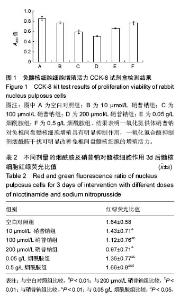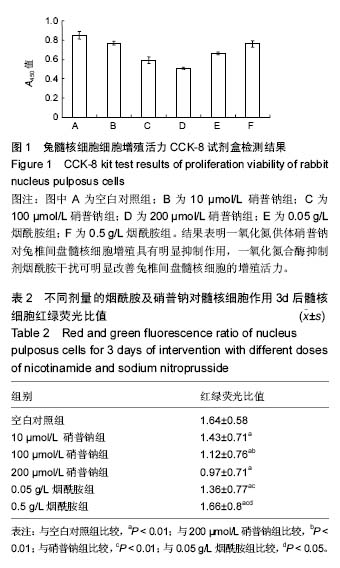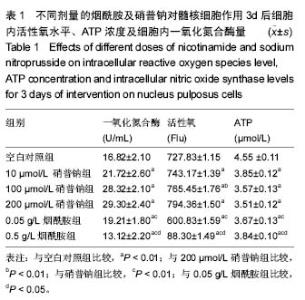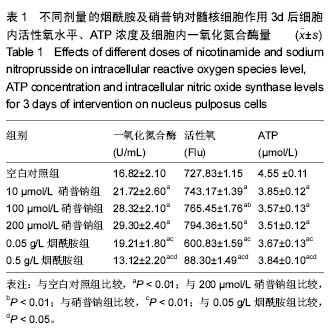| [1] 聂克,杨述华,熊蠡茗,等.AMPK与P16ink4а在退变腰椎间盘髓核组织中的表达及其意义[J].中国中医骨伤科杂志, 2009,17(1):8-10.
[2] 柳根哲,徐林,李春根,等.静水压对人体腰椎间盘一氧化氮产生及蛋白多糖合成的影响[J].中国临床康复,2005,9(2): 100-102.
[3] Le Maitre CL, Pockert A, Buttle DJ, et al. Matrix synthesis and degradation in human intervertebral disc degeneration. Biochem Soc Trans.2007; 35( 4):652-655.
[4] 徐蔚蔚,邵增务,郭兵,等.烟酰胺对椎间盘Ⅰ、Ⅱ型胶原的保护作用[J].中国中医骨伤科杂志, 2008, 16(6): 21-25.
[5] Benneker LM, Heini PF, Alini M, et al. 2004 Young Investigator Award Winner:vertebral endplate marrow contact channel occlusions and intervertebral disc degeneration.Spine.2005;30(2):167-73.
[6] Xu RB, Shao ZW, Xiong LM, et al. Experimental Study on Inhibitory Effect of Niacinamide on Tumor Necrosis Factor-alpha-induced Matrix Degradation of Annulus Fibrous Tissue in vitro. J Huazhong Univ Sci Technol [Med Sci].2008; 28 (5):576-579.
[7] Rannou F, Richette P, Benallaoua M, et al. Cyclic tensile stretch modulates proteoglycan production by intervertebral disc annulus fibrosus cells through production of nitrite oxide. J Cell Biochem.2003;90(1): 148-157.
[8] Liu GZ,Ishihara H,Osada R,et al.Nitric oxide mediates the change of proteoglycan synthesis in the human lumbar intervertebral disc in response to hydrostatic pressure.Spine.2001;26(2):134-141.
[9] 周建国,杨操,杨述华,等.一氧化氮对兔纤维环细胞生物学行为的影响[J].中国中医骨伤科杂志,2009,17(9):10-13.
[10] Schuessel K, Frey C, Jourdan C, et al. Aging sensitizes toward ROS formation and lipid peroxidation in PS1M146L transgenic mice. Free Radic Biol Med. 2006; 40(5):850-862.
[11] Duan DY,Yang SH,Shao ZW,et al.Protective effect of niacinamide on interleukin-1beta-induced annulus fibrosus type II collagen degeneration in vitro. J Huazhong Univ Sci Technolog Med Sci.2007;27(1):68-71.
[12] Ungerstedt JS, Blömback M, Söderström T. Nicotinamide is a potent inhibitor of proinflammatory cytokines. Clin Exp Immunol.2003;131(1):48-52.
[13] 熊晓芊,杨述华,邵增务,等.烟酰胺对椎间盘聚集蛋白聚糖的调控作用[J].中国中医骨伤科杂志,2005, 13(5): 1-4.
[14] Kohyama, Saura R, Douta M, et al. Intervertebral disc cell opatosis by nitric oxide: biological understanding of intervertebral disc degeneration. Kobe J Med Sci. 2000; 46(6):283-295.
[15] Nisoli E, Clement E, Paolucci C, et al. Mitochondrial biogenesis in mammals:the role of endogenous nitric oxide. Science.2003;299(5608):896-899.
[16] Cui LY, Liu SL, Ding Y, et al. IL-1beta sensitizes rat intervertebral disc cells to Fas ligand mediated apoptosis in vitro. Acta Pharmacol Sin.2007; 28(10):1671-1676.
[17] Xiong XQ,Yang SH,Shao ZW,et al.Up-regulates of Niacinamide in Intervertebral Disc Aggrecan in vitro. Journal of Huazhong Univerxity of Science and technology.2006;26(1):92-95.
[18] Zhou JG, Yang C, Yang SH, et al.The Protective Effects of Niacinamide against Axial Loading Induced Degeneration of Rabbit Lumbar Disc. Journal of Clinical Rehabilitative Tissue Engineering Research.2009; 13(33): 6448- 6453. |





